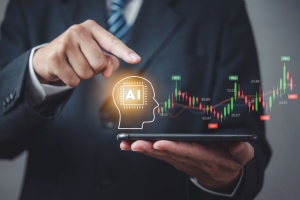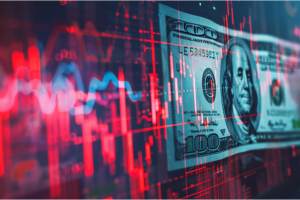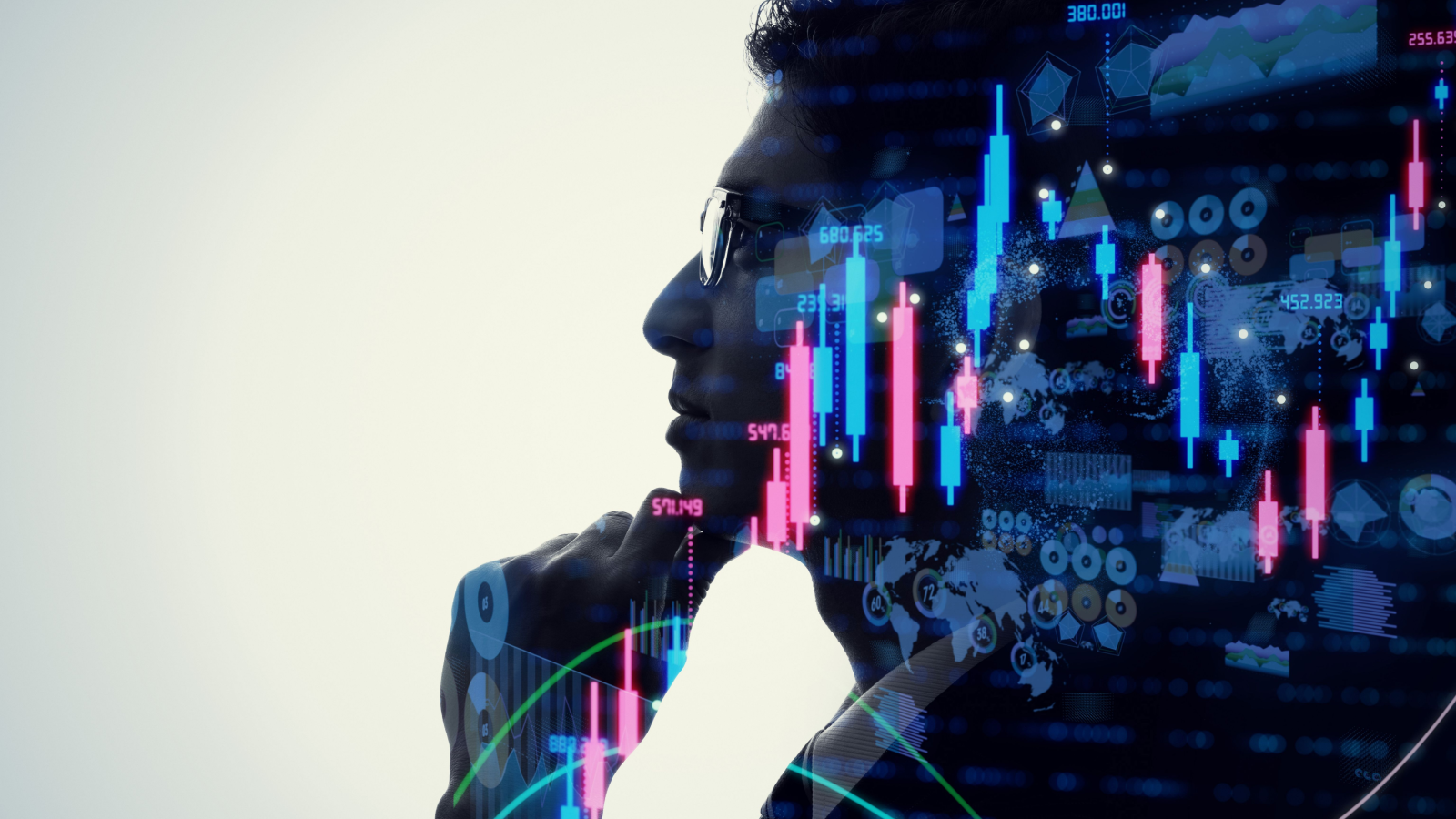
In 2008, I accidentally discovered a way to beat the market. By experimenting with the latest regression analysis techniques, I found that investors could pick up several percentage points per trade on some thinly traded commodities. My undergraduate thesis would involve using these methods on frozen concentrated orange juice, and my first job landed me in cotton trading.
When markets have fewer players, outperforming the crowd is relatively easy.
Liquid markets, however, are more competitive. Additional players mean successful algorithms are eventually copied, diluting their “alpha” to zero. Research finds that excess returns from anomalies drop by a quarter from discovery to publication and then by over 50% after that. Large markets also often undergo regime changes, which can turn profitable investment strategies into money-losing ones and vice versa.
What I needed was a system that could adapt to new situations.
Fortunately, advances in artificial intelligence now make this possible. This is especially true with machine learning, which creates models that improve with time. It’s how Google’s AlphaGo managed to beat a world champion in 2016. And it’s why large language models — like the one that powers ChatGPT — can sound so convincingly present in a conversation.
These systems “learn” new patterns and constantly improve.
The same techniques can be applied to stock markets as well. And with enough training data, the results can be stunning.
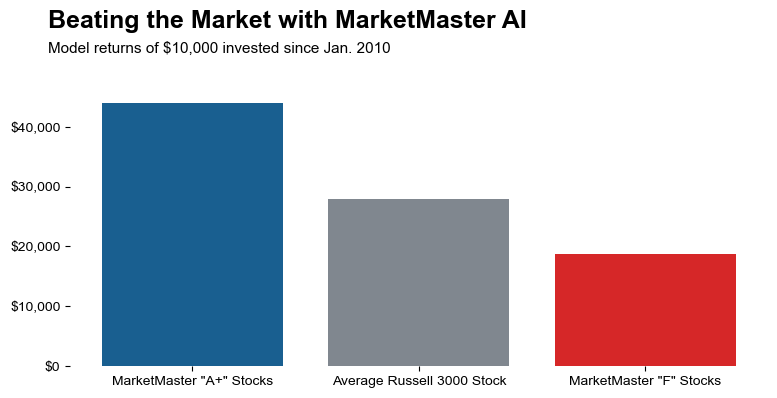
1. The MarketMaster AI System
MarketMaster AI is a machine-learning system with a proven record of outperforming the market. The neural network has been trained on millions of data points spanning fundamentals, prices, forward estimates and other predictive factors, based on decades of studies. The system then scores companies on an A+ to F scale on how it predicts the stocks will perform over the next six months. The better the score, the greater the chance of outperforming over that timeframe.
For instance, the system awarded Advanced Micro Devices (NASDAQ:AMD) an A+ grade at the end of December 2022. Here’s what AMD then did over the following six months.
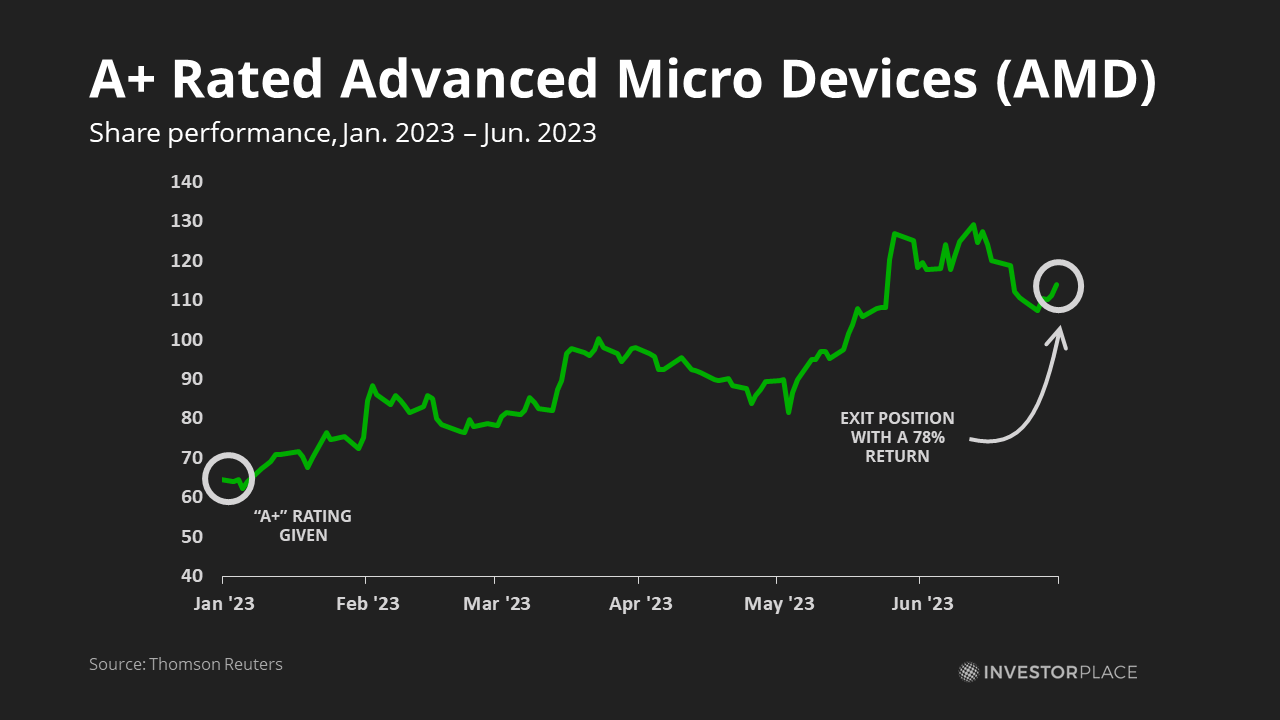
And here’s another A+ rated company, Redfin (NASDAQ:RDFN). This MarketMaster AI pick did even better with a 188% return.
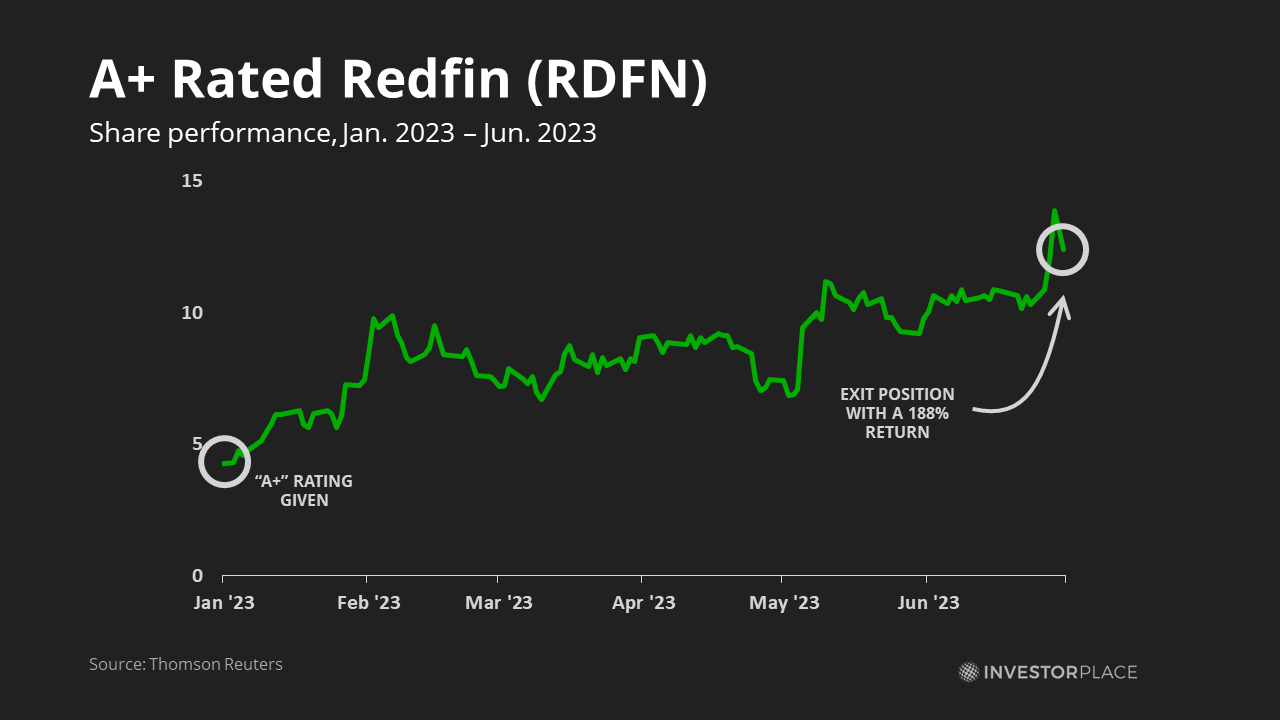
It’s also possible to flip the system around and use it to find stocks to avoid. For example, here’s what happened with F-rated Lordstown Motors (OTCMKTS:RIDEQ), an electric vehicle startup that the system consistently graded as a stock to sell. Investors would have exited their position just as the company was declaring bankruptcy.
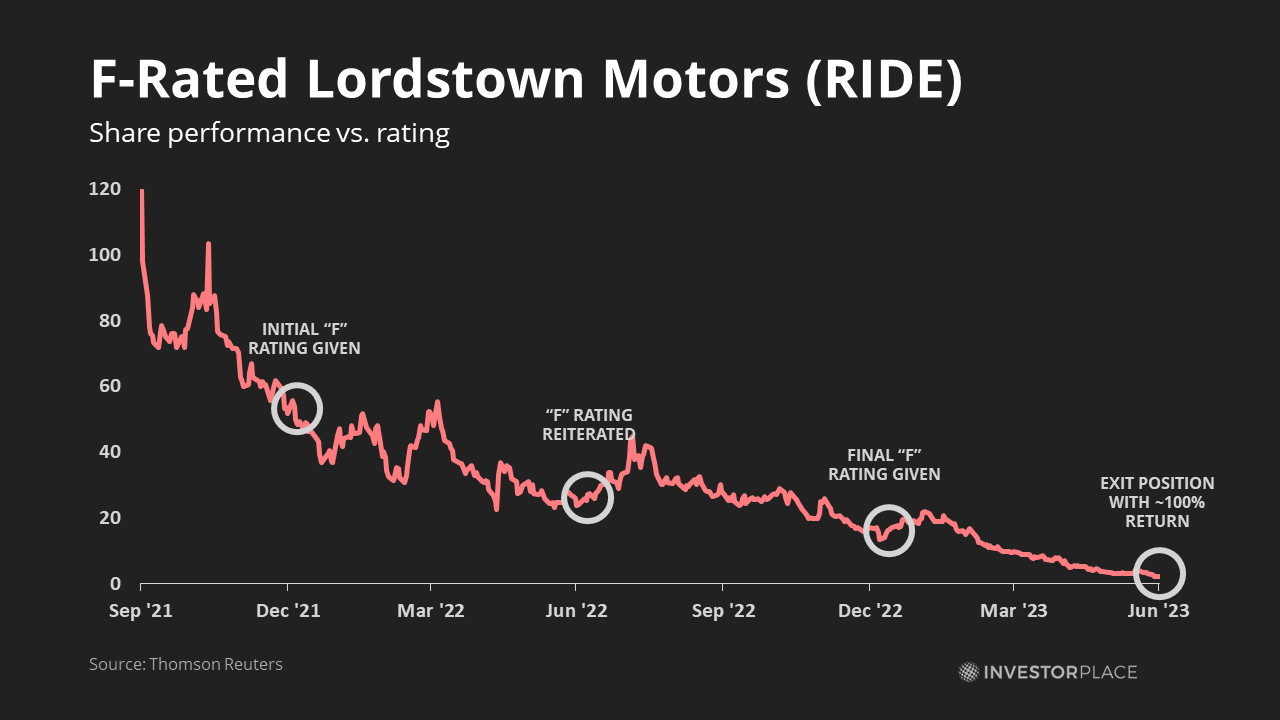
There are plenty more examples of these types of picks.
In fact, we can go back and see how all of the system’s picks would have performed. Below is the performance of MarketMaster AI from 2010, given only the available information at the time. Here, we see that the system’s A+ stocks have consistently outperformed those with F scores. The system performs even better after 2016, when the Institutional Brokers’ Estimate System (I/B/E/S) forward estimates become available in sufficiently large training quantities.
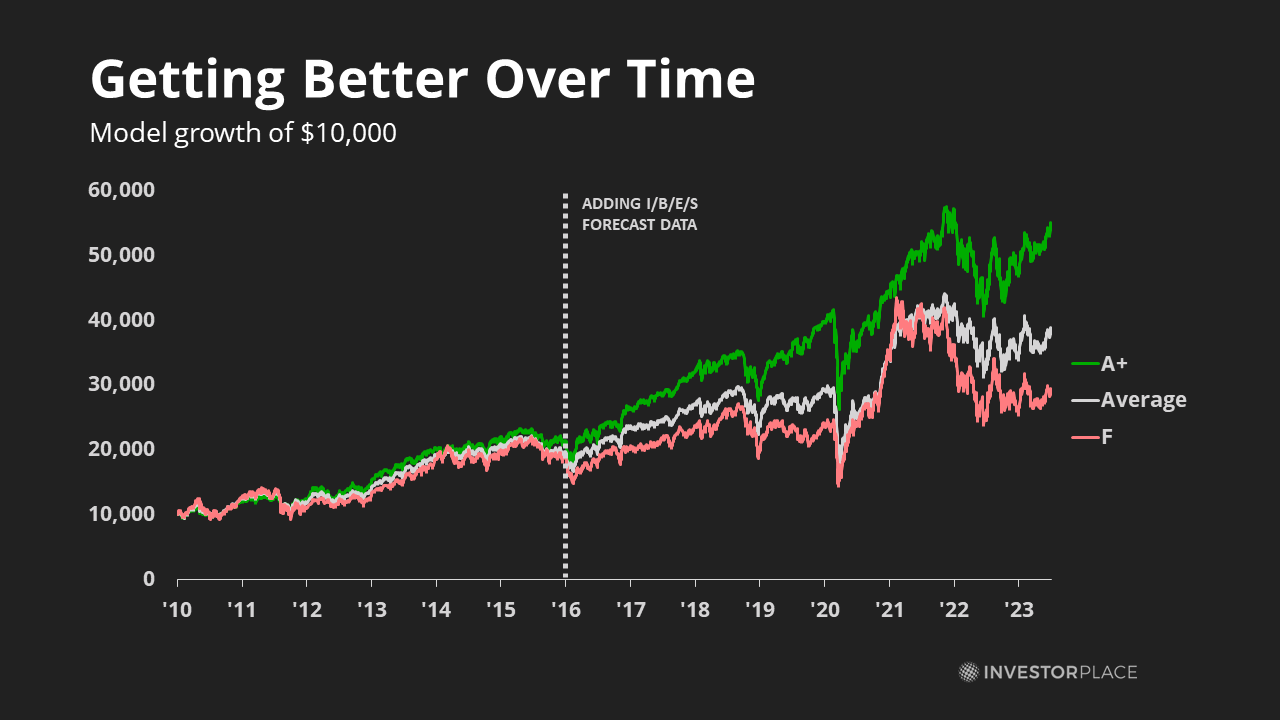
In the end, an investor who bought only A+ rated stocks would have done twice as well as investors who purchased the bottom-rated ones.
2. The Importance of MarketMaster AI
Machine learning is becoming essential for investors. Financial data is now generated far faster than any individual can consume. And high-frequency traders now dominate the market. These well-informed traders now make up over 50% of all trades, up from 3% of volume in the mid-90s.
In other words, even if you aren’t using AI to help pick stocks, you can be sure everyone else is.
That’s creating an immense divergence between the “haves” and “have-nots” of the stock investing world. According to data analytics firm VandaTrack, the average retail investor lost almost 30% of their portfolio between late 2021 through mid-2023. Even those who turned to passive indexing would have lost money. During the same period, the S&P 500 lost 10% of its value, even as inflation approached double digits.
Meanwhile, high-powered hedge funds like Renaissance Technologies continue to power ahead. According to publicly available data, the Connecticut-based fund is up double digits, while many have done even better. For every investor who underperforms the market, we know there must be another player who has outperformed.
The divergence will only grow as machine-learning techniques become more advanced. We’re even seeing hedge funds begin to infiltrate the less-efficient corners of the market, reducing the potential “alpha” that specialists once enjoyed. It’s no surprise that retail investors are turning to zero-day options and other risky bets to keep up.
Fortunately, MarketMaster AI helps investors level the playing field. By churning through the reams of data that the Russell 3000 companies produce, the neural network allows investors to divide stocks into high-potential picks and low-potential ones. Even buying stocks randomly from the right bucket can increase returns by 100%.
3. An In-Depth Look at MarketMaster AI
MarketMaster AI uses neural networks, a machine-learning (ML) technique that mimics neurons in a brain. Instead of brain cells, neural networks use digitized matrices of ones and zeroes to “store” data. And rather than neurotransmitters and axons connecting cells together, the system has mathematical rules that determine how these “brain cells” interact. The result is a network with millions of potential connections that automatically updates itself when presented with new data.
The AI system also employs an “ensemble method” to create predictions. Think of it as multiple violins playing together in an orchestral ensemble, where individuals work together to create a better outcome. In our ML case, MarketMaster AI polls multiple independent neural networks for a final “vote” for a stock’s price prediction. Only stocks with unanimous bullish ratings receive the top A+ score.
It might sound complicated, but the outcome is straightforward. By combining all these methods, MarketMaster AI can analyze millions of data points for thousands of companies, and then determine A+ through F scores that are provenly predictive of a stock’s six-month return.
More details of MarketMaster AI:
- Model. The system uses an ensemble method of dense neural networks with dropouts, a technique pioneered by one of the “Godfathers of AI” Geoffrey Hinton. It also updates itself with more information as it becomes available.
- Data Source. The MarketMaster AI dataset is based on information from Refinitiv, a Thomson Reuters service that includes the Datastream service and Institutional Brokers’ Estimate System (I/B/E/S), two gold standards in the financial data world. This data spans back to 2006, which covers the period after the Sarbanes-Oxley Act that standardized financial reporting to today’s equivalents. I/B/E/S analyst forecasts were added in 2016.
- Universe. The system includes all Russell 3000 companies, except for financials (different accounting methods), biotech startups (returns dependent on FDA approvals) and companies without sufficient financial history. The system also includes defunct and dellisted firms, which prevents survivorship bias. If a company went bankrupt or was merged during its holding period, returns are adjusted to fit the facts.
Most importantly, MarketMaster AI is built using a proprietary mix of fundamental, technical and macroeconomic indicators that are proven to outperform the market. This unusual mix of inputs allows the system to benefit from both price movements and longer-term trends.
4. MarketMaster AI and Its Competitive Edge
Most hedge funds rely on algorithmic trading to earn their keep. Their fully automated systems are often capable of executing hundreds — if not thousands — of trades per second, and they live and die by their approach to risk management. When you’re making trades so quickly, even a 0.0001% profit margin can soon add up. Many “smart-beta” funds also mimic these fully automated systems on a slower scale, creating specific rules of which stocks to buy and sell (i.e., low price-to-book, high growth, superior ROE).
Quantitative investing has also found itself in more traditional stock-picking settings. Today, many money management firms have large quant departments that help their portfolio managers and analysts make better decisions. An energy analyst might use a quantitative system to analyze oil prices and then predict future prices.
MarketMaster AI is a combination of these two systems. The data that flows into the system looks more like what a traditional stock analyst might use. This includes fundamental data, pricing and specialized metrics. Meanwhile, the data processing looks more like what hedge funds use.
Of course, some will rightly wonder why these techniques work. After all, if markets were truly efficient, someone else would have done it by now.
Three key reasons emerge.
- Constant updating. The machine learning element of MarketMaster AI constantly updates itself as new information arises. This automatically refreshes its strategies and helps the system avoid trades that no longer work. The system improves over time, rather than going stale.
- Longer-term outlook. The system invests with an unusually long six-month window — an eternity in the world of high-frequency trading. This allows us to look beyond short-term volatility and avoids the hypercompetitive world of high-frequency trading.
- Proprietary data. The system uses input factors that have been carefully curated and developed over decades. Many “common” factors like price-to-earnings (P/E) ratios and price-to-tangible book value are avoided since they no longer have predictive power.
These qualities set MarketMaster AI apart from other trading systems. Its automated algorithms make it more resistant to human-like investment biases, while a longer timeframe helps it avoid the most competitive areas of algorithmic trading.
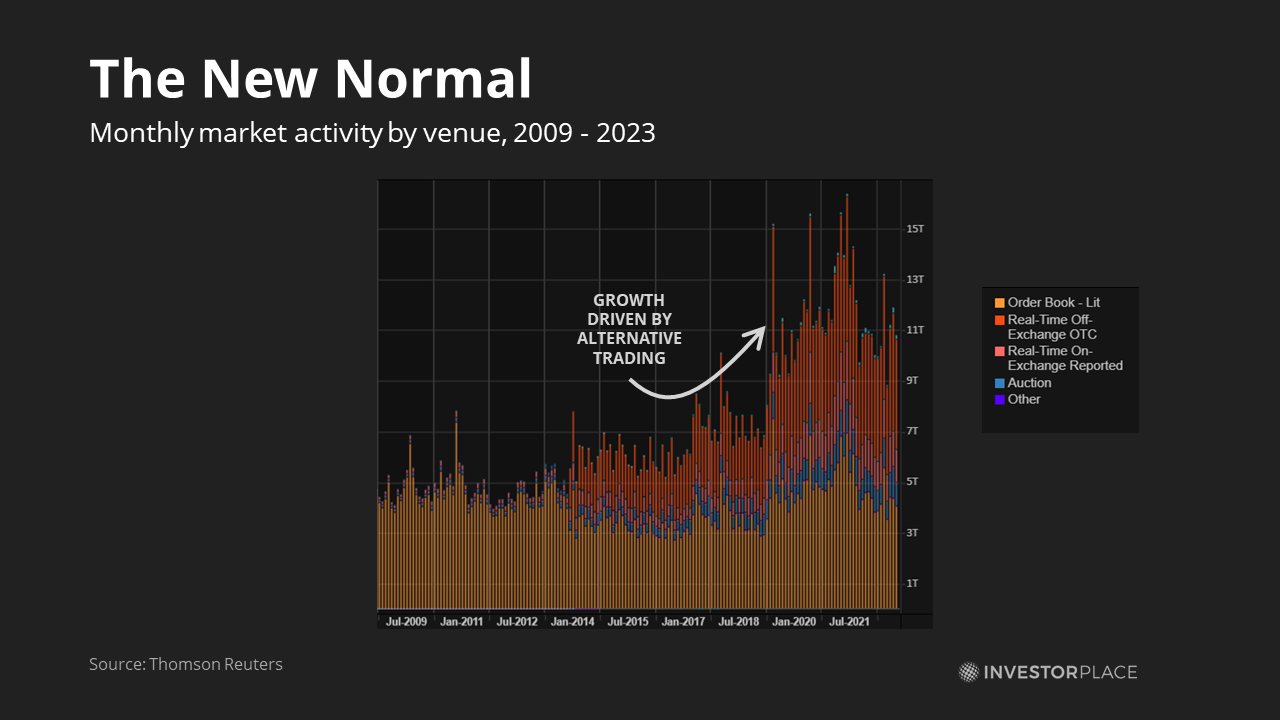
63% of all North American trading now occurs on non-traditional venues, a product of algorithmic trading.
5. How to Use MarketMaster AI
MarketMaster AI ranks companies based on an A+ to F scale that predicts whether a company will outperform or underperform the market. On average, A+ companies do better than A companies, which do better than B companies and so on. The average market return sits slightly under the C grade.
| MarketMaster Score | Average Annual Return | Suggested Action |
| A+ | 9.8% | Strong Buy |
| A | 8.77% | Buy |
| B | 8.19% | Weak Buy |
| C (Average) | 7.38% | Hold / Buy on Dips |
| C- | 5.58% | Hold / Sell if Possible |
| F | 2.41% | Avoid if Possible |
Of course, these are only average returns. Not every A+ stock goes up in price, nor does every F pick go to zero. As I’ll demonstrate later on, MarketMaster AI can make some obviously poor choices, especially when traditional financial data is misleading. (Zero-revenue biotech startups, for instance, can rise 5x or more on FDA drug approvals).
Also, stocks can be incredibly volatile. The price of an average stock moves somewhere between 15%-20% every six months, and plenty more go further. That means even a correct six-month prediction can turn into a wild ride. F-rated Bed Bath & Beyond (OTCMKTS:BBBYQ) more than doubled before reaching zero in its specular 2023 bankruptcy. That means any leveraged strategy will need appropriate risk controls.
Nevertheless, the enormous performance difference between A+ and F stocks means MarketMaster AI can help both novice and experienced investors.
Use Case 1: Do It for Me (DIFM)
Newer investors can consider A+ stocks without needing much additional input. Many Smart Beta funds use this same “do it for me” approach, relying on automated rules to make longer-term investment decisions. If you choose enough stocks (at least 20) and diversify across sectors, your returns should approach the average of all A+ picks.
In this case, position sizing should be done relative to market capitalization. Big companies get more significant investments, while small-caps are bought more sparingly. My research shows that doing so helps reduce volatility without any noticeable decrease in performance.
Use Case 2: Idea Generation
More advanced investors can use MarketMaster AI as an idea generator, especially for stocks beyond their specialty. For instance, under-the-radar industrial firms like water heater firm A.O. Smith (NYSE:AOS) and crushed stone company Vulcan Materials (NYSE:VMC) began emerging as top-rated A+ firms in 2023. I don’t know about you, but these industrials are not firms I would have ordinarily considered. (The two would rise 25% in under six months!)
This is particularly useful for diversification. Not every investor will be an expert in telecom, utilities or healthcare. And even the top healthcare analysts will often know nothing about online retailers. The MarketMaster AI scores can help guide investment decisions in these lesser-known areas.
Use Case 3: Choosing Between Stocks
Finally, experienced investors can use the system to enhance their decision-making. Consider Advanced Micro Devices once more. In 2023, investors seeking an alternative to Nvidia (NASDAQ:NVDA) would have faced several choices. AMD was catching up in server chips, Qualcomm (NASDAQ:QCOM) was making headway in automotive AI, and struggling Intel (NASDAQ:INTC) was trading for an unusually cheap price. A traditional investor would have correctly noted all three were promising investments.
But what if that investor wanted to increase their odds of outperforming?
Here’s where the scores can help. Below are how the three semiconductor companies scored in January 2023:
- Advanced Micro Devices: A+
- Qualcomm: C
- Intel: C-
MarketMaster AI has no trouble choosing favorites. Indeed, AMD would go on to quintuple the market’s returns in the first half of 2023. Intel and Qualcomm would also rise but by a fraction of AMD’s total gains.
6. Working With MarketMaster AI: The ‘Centaur’ Approach
In 1997, IBM’s chess-playing supercomputer Deep Blue beat world champion Gary Kasparov in a now-infamous tournament. For a brief moment, it seemed like computers would take over the world (or at least the game of chess).
But it turns out that even the fastest supercomputers are still beatable. In 2005, two amateur chess players used three ordinary computers to beat Hydra, a chess-playing program even more advanced than Deep Blue. Other human/machine hybrids have since done the same.
These “Centaur” teams take the best of both worlds — the rapid calculations of computers paired with soft skills from humans. And the combined output makes these teams even better than all-robot or all-human teams.
MarketMaster AI follows the same principle: Old-fashioned financial analysis further improves the system.
Consider the tail end of the meme-coin rally in 2022. In the middle of that year, MarketMaster AI upgraded cryptocurrency miners to A ratings for their hyper-fast returns on investment and incredible topline growth. In fact, the system believed that the declining share prices of Marathon Digital (NASDAQ:MARA) was a perfect opportunity to “buy the dip.” Historically, companies with these characteristics outperform the market by up to 25% over the following six months.
But a “Centaur” team would have done even better. We would have known that Marathon’s asset prices are closely linked to Bitcoin (BTC-USD) prices, since its “inventories” are mined cryptocurrency. And we would have overridden MarketMaster’s recommendation to buy.
Instead, we might have gone further down the recommended list and chosen A+ rated BYD (OTCMKTS:BYDDY) instead. Electric vehicles were gaining popularity just as crypto was on the decline, and Chinese-based BYD was in a perfect position to gain.
There are plenty of other instances where MarketMaster AI gets things wrong. Consider the 2020 work-from-home rally that sent companies like Bowflex maker Nautilus (NYSE:NLS) from the $1.30 range to over $30. An AI model trained on fundamental and pricing data would have seen money-losing Nautilus as a poor investment. The exercise equipment maker was short on cash and only had several months to live. Yet, even the most cynical investor would have known to override the neural network’s outputs in April 2020 when gym equipment was flying off the shelves.
Still, we must remember that the system isn’t perfect. It only seeks to increase the average performance of A+ rated stocks. That means it will pick up stinkers along the way. Even the best systems will struggle to identify which dying mall retailer will become a meme stock… or which indebted turnaround will find 12th-hour funding and survive. That means investors still need to do due diligence on all recommendations, and limit bets to an appropriate level of risk.
7. Future Developments and Enhancements of MarketMaster AI
The MarketMaster AI system will constantly evolve as more data becomes available. Not only will the system “learn” from current history as it unfolds. The eventual addition of non-traditional metrics will further enhance performance. These metrics, such as credit card spending, web traffic and social media sentiment, are proven to add “alpha” to predictive models.
Investors can also expect MarketMaster AI to create timely predictions. A+ stocks will eventually come with short-term buy signals, so buyers know whether to buy stocks tomorrow or a week from now. And lower-rated D and F stocks will include short-squeeze alerts and other near-term warnings for short sellers.
Essentially, the system will adapt to future market trends and changes both organically and through upgrades. I noted earlier that trading algorithms in competitive markets often have a “decay” in their effectiveness, earning less as time passes. Even less liquid markets like over-the-counter (OTC) stocks and agricultural commodities are finding themselves targets of quantitative traders. Only by constantly evolving can any investor (and Centaur team!) hope to keep up.
Conclusion: The Impact of MarketMaster AI on Investing (300 words)
Professional investors have long found ways to beat the market. Benjamin Graham and Warren Buffett popularized the notion of “value investing,” where people buy shares at a discount. Phil Fisher discovered that “growth investing” worked equally well since investors only need a handful of big winners to come out ahead. “Momentum investing” came later with papers by Cliff Asness and others.
But it’s never been obvious how to stay ahead consistently. Warren Buffett evolved into a quality-growth investor as value became harder to find. And momentum effects tend to work right until they don’t, especially during market bubbles. Even simple trading models like regression analysis and expert systems tend to degrade over time.
That’s what makes MarketMaster AI different. The machine-learning system is designed to take new data and improve with time. Strategies that work well are repeated, while those that no longer perform are discarded. If investing were a game of chess, MarketMaster AI is a computer program that analyzes competing moves and suggests what to do next.
The system will become even more essential as algorithmic trading continues to grow. Computers trade differently from humans, and assets like meme stocks and crypto act far differently from their traditional counterparts. Algorithms that buy stocks trending on social media often create self-fulfilling prophecies when rising prices draw in fresh investors.
That means even the most experienced investors need to learn new skill sets. Like chess grandmaster Gary Kasparov, we no longer exclusively compete against human players. And if we want to beat the machines at their own game, we’ll need to work with them. It’s the future of investing.
As of this writing, Tom Yeung did not hold (either directly or indirectly) any positions in the securities mentioned in this article. The opinions expressed in this article are those of the writer, subject to the InvestorPlace.com Publishing Guidelines.


